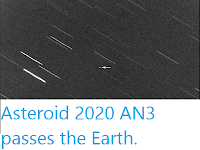Asteroid 2020 BB5 passed by the Earth at a distance of about 265 500
km (0.69 times the average distance between the Earth and the Moon, or
0.18% of the distance between the Earth and the Sun), at about 0.20 am
GMT on Wednesday 22 January 2020. There was no danger of
the asteroid hitting us, though were it to do so it would not have
presented a significant threat. 2020 BB5 has an estimated
equivalent
diameter of 2-7 m (i.e. it is estimated that a spherical object
with
the same volume would be 2-7 m in diameter), and an object of this
size
would be expected to explode in
an airburst (an explosion caused by superheating from friction with the
Earth's atmosphere, which is greater than that caused by simply
falling, due to the orbital momentum of the asteroid) in the atmosphere more than 36 km above the ground, with only fragmentary material
reaching the Earth's surface.
The calculated orbit of 2020 BB5. JPL Small Body Database.
2020 BB5 was discovered on 23 January 2020 (the day after its closest encounter with the Earth) by the University of Arizona's Mt. Lemmon Survey at the Steward Observatory on Mount Lemmon in the Catalina Mountains north of Tucson. The designation 2020 BB5 implies that the asteroid was the 122nd object (asteroid B5 - in numbering asteroids the letters A-Y, excluding I, are assigned numbers from 1 to 24, with a number added to the end each time the alphabet is ended, so that A = 1, A1 = 25, A2 = 49, etc., which means that B5 = 122) discovered in the second half of January 2020 (period 2020 B).
2020 BB5 has a 592 day orbital period and an eccentric orbit tilted at an angle of 0.46° to the plane of the Solar System, which takes it from 0.86 AU from the Sun (i.e. 86% of he average distance at which the Earth orbits the Sun) to 1.90 AU from the Sun (i.e. 190% of the average distance at which the Earth orbits the Sun, more distant from the Sun as the planet Mars). It is therefore classed as an Apollo Group Asteroid (an asteroid that is on average further from the Sun than the Earth, but which does get closer). This means that 2020 BB5 occasionally comes close to the Earth, with the such encounter having happened in August last year (2019) and the next predicted for January 2025.
2020 BB5 also
has frequent close encounters with the planets Venus, which it last
came close to in July 1974 and Mars, which it last came close to in August 1976 and is predicted to pass again in January 2043. Asteroids
which make close passes to multiple planets are considered to be in
unstable orbits, and are often eventually knocked out of these orbits by
these encounters, either being knocked onto a new, more stable orbit,
dropped into the Sun, knocked out of the Solar System or occasionally
colliding with a planet.
See also...
Follow Sciency Thoughts on Facebook.







